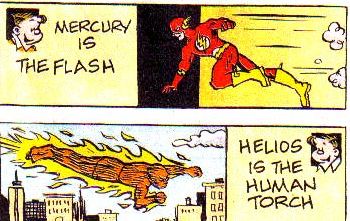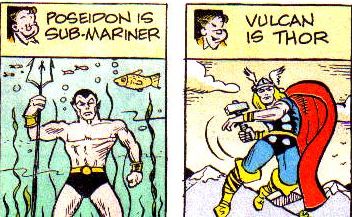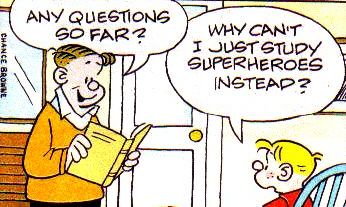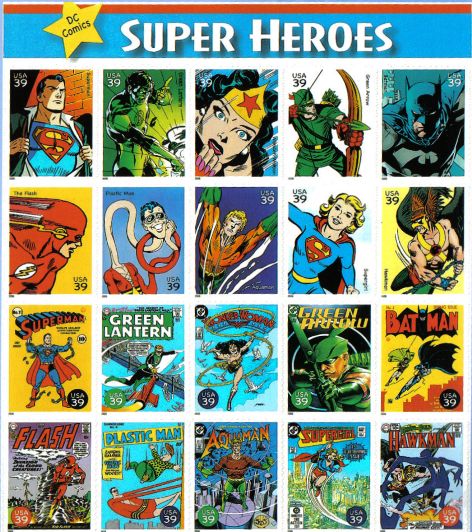Why My Mother Threw Out My Comic Books
(Part 3 of 3 Webages: The Comics after 1955)
by Adam Blatner
In Part 1, the history of comics from 1890s through around 1949 is summarized briefly.
In Part 2, the national pressure to reform the excesses of comic books and the adventures especially of the EC comics line in all this.
In this Part 3 we'll talk about a few of the high points of the history of comics since 1955. In fact, this history is extensive, and this webpage simply wraps up the story that began with the invention of comic strips and then comic books (see part 1); and then had a small crisis in its development (in part 2), which I discuss with a bit of focus on the events associated with the EC lines of comics. Some othe philosophical and social questions will be addressed---though no final answer is offered.
MAD Continues
The Silver Age
The Congressional Hearings and the first Comics Code marked the end of the Golden Age of Comics, so labeled by a variety of comic book historians. This wasn't all due to Dr. Wertham's testimony, though; the growing power of television was a big part. Many comics, such as the Disney Comics, were hardly bothered. Nevetheless, in a rather complex story involving Stan Lee as publisher and Jack Kirby as a major artist, Marvel Comics and other publishers began to create new characters, superheroes, but now taking on a few interesting twists:1. The heroes were more psychologically complex, often embodying some interesting quirks that affected their general mission. This made it possible to add some twists in the plot. (I'm reminded of the later character of the teen Marty McFly in the Back to the Future movies in the late1980s, who, given the benefit of time travel, does well, but also gets in trouble because of his character flaw, a "counter-phobic neurosis": If challenged as weak or frightened, he feels compelled to engage in just the dangerous action that he fears, to prove to himself and others that he's not frightened: Sometimes this backfires, generating more dramatic tension in the story.)
2. There's a move more into the cosmic and interdimensional, and the theme of the activities of gods---while not confronting mainline religion---still open the question of there being vast cosmic potentials being dealt with on a grand stage. Some hints of this abound in written sci-fi literature, and in the emerging Star Trek and other sci-fi movies of the 60s and 70s.
3. There are occasional suggestions that the characters (and hence the artists) acknowledge the existence of the readers as audience, and sometimes even kid themselves and their own medium a little.
The Marvel characters of Kirby have become quite iconic! In this picture of the artist at work you can glimpse some of his more famous creations, including the Norse god Thor (with his hammer), Aquaman, Spider-Man, the Silver Surfer, and so forth. (The story on the left was made into a movie a few years ago!)
I discern in not just the drawings of this Silver Age comics, but the cultural response to them a process of "re-mythologization" (what a mouthful!)---an opening to the mythic dimensions that people do subconsciously. (The analytical psychologist and psychiatrist Carl Jung spoke to this aspect of the mind-in-culture, and the comparative mythologist Joseph Campbell helped explain the pervasiveness of this phenomenon.)
A number of other cultural trends weave together, and we can see mythic elements in so many aspects of culture, from the series of Lucas' Star Wars movies to the more recent Harry Potter series of books. Part of this speaks to a hunger for re-enchantment, a participation in the intuitive, imaginative, and emotional dimensions of consciousness-raising. IThe culture for a century or more had perhaps drifted over-much towards the valuation of the rational and the marginalization of the non-rational and trans-rational dimensions. Part of the psychedelic and hippie revolution fed into and expressed a deeper cultural expansion of the category of spirituality---which differs from mere superficial religiosity. New religions from the East have fertilized the field and what is emerging is a more interspirtual range of phenomena. (See other articles on this website that address spirituality.)
 |
 |
 |
Underground Comix
From this culture emerged a number of artists who
Art Spiegelman was another underground artists whose venture into the form of the graphic
Re-connecting to the EC Comics
Interestingly, Spiegelman wrote recently in a somewhat autobiographical illustrated book his own background and influence of his growing up with MAD comics and how those pictures influenced him:Anyway, one of the points to be made is that comics rebounded, even with the code. Indeed, the history of comics after the 1960s has expanded into many different arenas:
Graphic Novels
As mentioned above, Maus broke some ground in the sphere of recognition. However, it was certainly not the first graphic novel. Indeed, a few of these had been tried around 1930s:One was titled "God's Man," and another, by the popular comic strip artist Milt Gross, was one of my favorites: He Done Her Wrong. Most graphic novels have a variable amount of written dialogue in word-balloons or added narrative, but this particular novel is among those---and one of the first in this sense---to have absolutely no words. It's a classical melodrama, "The Great American Novel" being its subtitle. Funny! Charming. Graphic novels and autobiographical pieces began coming out more frequently after the 1970s, and the size of that section in the library continues to grow. Many are really for adults rather than children. Yes, a few have more sexual content, but by 'adult' I refer more to addressing the complexities of illness, adolescence, relationships, politics, and so forth.
Art
Comic Book Collecting
Very few kids in the mid-50s consciously collected comic books, thinking they'd be worth money some day. That did gradually begin in the 1960s and by the 1970s there began to be books published with prices noted for hard-to-find or top-quality old comic books. That has continued to the present. Apparently there was even a bit of a "bubble" in ths regard, some publishers publishing an overabundance of new lines, trying to make some money on those who were trying to build up collections. That bubble collapsed, but collecting, with less naive enthusiasm, continues.
Comic Conventions (Comic-Cons)
Another trend beginning in the 1970s was the idea of holding a convention of comic book fans, comic book artists, sales, and related paraphernalia. Starting in San Diego around 1970, the most notable one grew from 300 participants to over 100,000 in recent years!! In addition, there are now many spin-offs, regional and local conventions with smaller attendance. The point is that there is a significant niche market and sub-culture focusing on comic books.
International Developments (Manga, etc.)
There were comic strips started in Belgium (Tintin, by Hergé, in 1929) later turned into books; or the Asterix the Gaul series started in 1959.) Manga, a Japanese type of comic book has become very prevalent and read by all ages, with different sub-types appealing to different age groups and interests. Some of these are even pornographic. In Korea, Manha is similarly widespread. The point here is that comic books, graphic novels, sequential art, all have become much more prevalent in other countires in the last five decades.Direct Sales
Also in the 1970s, comic book publishers shifted the marketing from it being more like consignment work, taking back those that didn't sell, to direct sales. Deeper discounts to the middlemen, but no returns. This supported the emergence of a new institution---the store that specializes in comic books. Such stores often specialize also in fantasy role-playing board games such as Dungeons & Dragons, and the models associated with that activity. A few comic-books are still available at some supermarket or Wall-Mart-type stores in the books and magazines area, but not that many.Comics Journals
Also beginning in the decades following the 60s, actual journals---semi-professional---surveyed the comics scene, including graphic novels, comic strips, comic books, and other media. There are a number of these now.. They carry articles about artists, themes, history, and commentary.Academia
Comic books were lowbrow populist kid's junk until a few academics beginning in the 1970s began to take this modality as a serious art form. That has grown in colleges and universities, and more than a few art departments address sequential art and cartooning along with the more traditional painting and drawing subjects. Books about comics---academic analyses, aesthetic, historical, political, are also emerging in increasing numbers. |
Entering the Mainstream
In 2006, the United States Post Office devoted a special issue to major super- heroes of the 1950s and 60s.The themes of comics more recently are quite diverse, but my impression is that they tend to be caught up in violence and dark themes, often demonic. The art isn't that varied, and in truth I am inclined to---indeed, planning to---offer my own version that invites people to imagine in a more positive fashion---see my associated website about the World of Almost-Real and the elves portrayed to the left.
.
Addendum:
In an article titled Super Powers: Turning a Dime Into a Million Bucks,
in the Week in Review section of the in the New York Times’ Sunday
edition of February 28, 2010, George Gene Gustines writes: Here
is a lesson for all those parents who threw away their children's comic
books: Last Monday, a copy of Action Comics No. 1, in which Superman
first appeared in 1938, sold for a record $1 million. (See cover
pictures below.) That price was eclipsed on Thursday by the $1,075,500
auction of a copy of Detective Comics No. 27, where Batman made his
premiere in 1939. Not bad hauls for comic books that originally sold
for 10 cents each.But this doesn't mean that the masses who converged on comic book stores in January 2009 to grab Amazing Spider-Man No. 583, featuring President Obama, can trade in that issue for a deposit on a dream house. The recipe for what makes a comic book so valuable is a mix of content, rarity and condition.
Not surprisingly, the Man of Steel had it all. Superman was the trailblazer for all other superheroes, and fans at the time agreed: the alien visitor proved so popular that he took over Action Comics, which was originally an anthology of different stories and characters. "We had long theorized that Action No. 1 would be the comic to break the million-dollar barrier," said J.C. Vaughn, the associate publisher_ of the "Official Overstreet Comic Book Comic Price Guide," an industry bible. That first issue, Mr. Vaughn estimated, sold 130,000 copies; only about 100 remain. The buyers of those record-setting Superman and Batman comics, perhaps emulating the superheroes, have kept their identities secret. The condition of the Superman comic, sold by the auction house Comic Connect, was graded 8.0 out of a possible 10. Another copy, graded at 6.0, sold for $317,200 last year. The Batman book, sold at Heritage Auctions, was also graded 8.0. Fewer than 100 copies are believed to exist. A grade of 10 would signify a pristine book; an 8.0 indicates imperfections like a cover crease or Stress marks on the spine.
In the 1990s, speculators flocked to the comic book market, buying issues in the hopes that they would increase in value. But print runs for popular titles also greatly increased. In 1991, the first issue of a new X-Men title, written by Chris Claremont and illustrated by Jim Lee, sold more than eight million copies. "When you have thousands or millions of copies, it's less likely a candidate" to increase in value, Mr. Vaughn said. The big money seems to be in first appearances. Last November, a 9.2-rated copy of Incredible Hulk No. 1 sold for $125,475 at Heritage Auctions; a 9.0-rated copy sold for $100,000 at Pedigree Comics. Here's a look at some of those first appearances:
Smashing Debuts
References
Fingeroth, Danny. (2008). The rough guide to graphic novels. New York: Penguin/Putnam.Fulce, John. (1990). Seduction of the innocent revisited: comic books exposed. Lafayette, LA: Huntington House.
Rhoades, Shirrel. (2008). A complete history of American comic books. New York: Peter Lang.
Ro, Ronin. (2004). Tales to astonish: Jack Kirby, Stan Lee, and the American comic book revolution. New York: Bloomsbury.
Shutt, Craig. (2003). Baby boomer comics: the wild, wacky, wonderful comic books of the 1960s. Iola, WI: Krause.
Skinn, Dez. (2004). Comix: the underground revolution. New York: Thunder’s Mouth Press/Avalon.
B